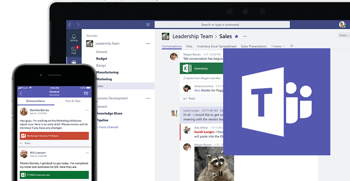It’s no secret that the field of computer science and information technology (IT) in general has long been considered a male-dominated industry and women have been slow to gain a foothold. However, despite their small numbers, that doesn’t mean that their touch cannot be felt in most areas of IT. In fact, women have played a significant role in many of the world’s scientific and technological advancements and invention.
According to some of the most recent data cited by the National Center for Women & Information Technology (NCWIT), women only hold 26% of professional computing occupations in the United States in 2017. Additionally, they only hold 17% of Chief Information Officer (CIO) positions at Fortune 500 companies. This is despite women representing 57% of all professional occupations.
Even though they’re in the minority, many women in technology have continued making a name for themselves in computer technology and the IT services industry.
In honor of Mother’s Day, the team at FPA thought a great way to pay tribute to the women in technology would be to sharing a little bit of how the work of these incredible women impacts many of the modern marvels we enjoy today.
Here are some of the most impactful women in technology (in no particular order):
Augusta Ada Lovelace
When compiling this list, we would be remiss to not include this innovative thinker. Born in the early to 1800s, Augusta Ada Lovelace, most commonly known as Ada Lovelace, is recognized as the world’s first computer programmer. It was in her work with Charles Babbage, a renowned mathematician who was writing about the concept of a prototype digital computer, that she created the world’s first machine algorithm.
The computer language Ada, created on behalf of the United States Department of Defense, was named after Lovelace. Since 2009, her contributions to the fields of science, technology, engineering and math (STEM) have been celebrated on Ada Lovelace Day, an internationally recognized annual holiday that falls on Oct. 15.
Williamina Paton Stevens Fleming
During the early 1880s, Edward Pickering, the head of the Harvard College Observatory, recognized a need to calculate data about the solar system to measure the universe. Without having much luck with getting his male colleagues to make the calculations, Pickering asked his housemaid, Williamina Paton Stevens Fleming (most commonly known today as Williamina Fleming), to do it. Fleming did that and more, according to her biography from the Harvard University Library — even going as far as “developing a new system to classify stars according to their spectra, or the unique pattern of lines caused by the refraction of a star’s light through a prism.” The university also reports that she cataloged more than 10,000 stars over the following nine years.
From that point on, Fleming worked as a “computer” at Harvard. She eventually established and led a team of more than 80 women “computers” at the institution.
Hedy Lamarr
Although she is most commonly known as a Hollywood starlet of the 1920s, Hedy Lamarr had much more to offer the world than her good looks and acting skills. Lamarr, along with co-inventor George Antheil, was responsible for developing a spread-spectrum radio frequency technology that involved frequency hopping between randomized channels to conceal technology communications. Their goal was to help the U.S. Navy remotely control and conceal Allied torpedoes from the Nazis.
Although their technology wasn’t used for that purpose, it was later used by the U.S. military to communicate secure messages. Now, decades later, their spread-spectrum concepts are still being used in many of the world’s modern wireless technologies, such as Wi-Fi, Global Positioning System (GPS), Code Division Multiple Access (CDMA), and Bluetooth.
The women of eniac
The idea that computation and programming was tedious women's work extended into the 20th century (right up until men found out how cool it was).
In the first half of the 20th century, Harvard's "computers" grew into a unit of female mathematicians at what would become NASA and its Jet Propulsion Laboratory, working during World War II on behalf of the U.S. Military. The calculations they did plotting missile trajectories were time consuming and exceedingly complicated. Two men decided to build a machine that could carry out these calculations. It was called the ENIAC, and it's now considered the first electrical computer.
But it was the women mathematicians who actually programmed the ENIAC. The ENIAC builders recruited six women who became the world's first coders, manipulating the ENIAC to calculate missile trajectories. The work they did for the army in the 1940s resulted in the first software program, the development of computer memory and storage, and the beginnings of programming language.
Susan Wojcicki
As the Chief Executive Officer (CEO) of YouTube, Susan Wojcicki has helped the company transform video viewing activities. Previously, she worked at Google since she joined up with the company in 1999; it was there that Wojcicki helped to create Google AdWords, an advertising system that allows companies to bid on keywords to appear on the search engine results page (SERP). She also urged company leaders to acquire YouTube in 2006.
Under Wojcicki’s leadership, YouTube has implemented machine-learning technology to be able to identify questionable content that also provides advertisers with more control over where their messages appear. The company also enjoyed $5.6 billion in advertising sales in 2016 alone — an increase of more than 30% over 2015.
Grace Brewster Murray Hopper
U.S. Navy Rear Admiral Grace Hopper, as she was most commonly known (along with the nickname “Amazing Grace”), was the brain behind some of the earliest English programming languages. She served in the U.S. Navy Reserve and was later assigned to the Bureau of Ships Computation Project at the Harvard Computation Lab at Harvard University.
Later, Hopper worked for the Eckert-Mauchly Computer Corporation, where she was part of the team responsible for developing the UNIVAC I computer and also served as a technical consultant for a committee that was responsible for defining the COBOL computer language. Among her many other accomplishments, Hopper also led the Navy Programming Languages Group as its director in the Navy's Office of Information Systems Planning.
Adele Goldberg
Without this woman, the Apple desktop environment might not look the way it does today.
As a computer scientist and researcher at the Xerox Palo Alto Research Center (PARC), Adele Goldberg worked side-by-side with men to develop the Smalltalk programming language and much of its documentation. This was used to help prototype the design and infrastructure for modern graphical user interfaces (GUIs).
In the PBS TV show Triumph of the Nerds, Goldberg revealed that she was forced by her superiors to show Smalltalk and the GUI to Steve Jobs and his team, even though she thought it wasn't a good idea to show Jobs their intellectual property. In the same show, Jobs said he was transfixed by Smalltalk, and that he knew the GUI technology Goldberg had helped developed represented the future of computing, and of Apple.
Susan Kare
In the graphics and design world, Susan Kare is a well-known name. Even if you don’t know her name, you’ll likely know her work. Kare has enjoyed an incredible career working for Apple, Microsoft, Facebook, and Pinterest. She was the creative mind and designer behind Apple’s early user interface, including the system’s happy Mac and command icons, and made the system more friendly through the use of her graphic design and typography skills.
Some of her iconic designs include the iconic trash can for dumping files, the pointing finger that represented “paste,” and scissors that symbolized “cut.”
These women of technology, along with many others that are founding businesses, have had and are making an impact in the industry. It is our hope that more women will be joining the ranks of female technology entrepreneurs who are making names for themselves in the field. With organizations like Women in Technology and programs like the Girl Scouts of America’s new cybersecurity badge, we hope to see more young girls gaining interest in IT and engaging with mentors in the field that they can look up to.
Who are some of the women in technology that you look up to? Share your thoughts in the comments section below or feel free to send me an email to discuss this topic more in-depth. And Happy (early) Mother's Day!
/fpa-logo-tagline.gif)






